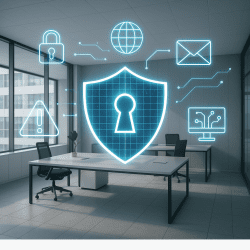AI & Cybersecurity Newsletter – U.S. Focused Edition (August 2025)
We are firmly into the second half of 2025, and AI is now inextricably linked to cybersecurity—reshaping regulations, insurance, compliance, and enterprise risk across the U.S.
Here’s what to focus on:
- Regulatory overlap: Map overlapping frameworks like FTC rules, NIST 2.0, and sector-specific laws—and aim for the highest standard.
- Zero Trust & AI: Zero trust architectures powered by AI are foundational—but require governance, transparency, and oversight.
- Incident reporting & supply chain: Faster breach reporting and formal supply chain security are now required for many sectors.
- Cyber insurance: Insurers demand evidence of AI-assisted detection, logging, segmentation, and access controls.
- Continuous monitoring: Review policies regularly, test controls, prepare for audits, and assess AI tool usage.
Key U.S. Regulatory & Policy Developments
🔹 FTC Safeguards Rule (Expanded 2024, Enforcement Ongoing in 2025)
Now applies to a broader range of businesses handling consumer financial data, including tax preparers, auto dealers, and accountants. The rule mandates written security programs, employee training, MFA, and vendor oversight.
Non-compliance can result in civil penalties and post-breach liability. ([Source: FTC.gov])
🔹 NIST Cybersecurity Framework 2.0 (Released 2024, Now Industry Standard)
Version 2.0 emphasizes governance, AI risks, and supply chain dependencies. The new framework is expected across all federal contractors and strongly recommended for critical infrastructure and regulated sectors.
Failing to align with NIST 2.0 can risk disqualification from federal contracts and insurance discounts. ([Source: NIST.gov])
🔹 CMMC 2.0 (Mandatory for DoD Contractors)
Department of Defense contractors and subcontractors must now undergo third-party certification to meet Cybersecurity Maturity Model Certification (CMMC) 2.0 requirements.
Required to win or retain DoD contracts—non-compliance is a disqualifier. ([Source: DoD Office of the CIO])
🔹 State-Level Privacy & Cybersecurity Laws
States like California (CPRA), Colorado (CPA), Virginia (VCDPA), and Texas (TDPSA) have implemented AI-aware privacy laws requiring breach notification, risk assessments, and algorithmic transparency.
Monitor emerging AI-specific proposals, such as the California Safe and Secure Innovation for Frontier AI Systems Act (pending).
🔹 Sector-Specific Compliance
- Healthcare: HIPAA updates emphasize AI-assisted diagnostics and third-party risk management.
- Finance: SEC cybersecurity rules require firms to report material cybersecurity incidents within 96 hours.
- Critical Infrastructure: TSA and CISA mandates now include continuous monitoring, AI integration, and incident response testing.
U.S. Federal AI & Cybersecurity Policy Movements
🏛️ AI Regulatory Preemption Push
House Republicans introduced legislation in July 2025 to block state-level AI laws for 10 years, favoring a national regulatory framework. Critics argue this weakens state-enforced privacy and cybersecurity.
This may delay tougher AI-related security rules in certain states. ([Source: WSJ])
🔁 CAISI: New Federal AI & Cyber Standards Hub
The AI Safety Institute under NIST was rebranded in June as the Center for AI Standards and Innovation (CAISI) to expand its role in defining secure AI system standards for use across government and industry.
Early guidance focuses on model testing, red teaming, provenance, and transparency. ([Source: The Verge])
🔐 Executive Orders & Federal Guidance
The Biden administration’s 2023 AI Executive Order remains in force, requiring:
- AI risk assessments in federal agencies
- Guidance for secure AI development and deployment
- New cybersecurity benchmarks for AI model safety and robustness
Federal procurement now requires vendors to follow these guidelines. ([Source: WhiteHouse.gov])
U.S. Industry Trends – AI Meets Cybersecurity
🤖 Anthropic’s Claude Dominates AI Cyber Exercises
Claude, a frontier LLM, outperformed human experts in recent cyber capture-the-flag simulations, illustrating the growing use of AI in both offensive and defensive cyber operations.
Organizations must prepare for AI-accelerated attacks and defenses. ([Source: Axios])
🔄 Agentic AI in Cyber Defense
Autonomous AI agents are being used to monitor networks, deploy patches, and detect anomalies in real time—but regulators warn that uncontrolled agentic AI may trigger compliance issues.
Use agentic tools only with human oversight and audit logs. ([Source: TechRadar])
🔍 Nvidia Responds to AI Chip Security Concerns
Under pressure from both U.S. and Chinese regulators, Nvidia publicly denied embedding kill switches or surveillance backdoors in its AI chips, citing the importance of supply chain trust and system integrity.
Hardware security is now a top concern for regulated sectors using AI infrastructure. ([Source: Washington Post])


